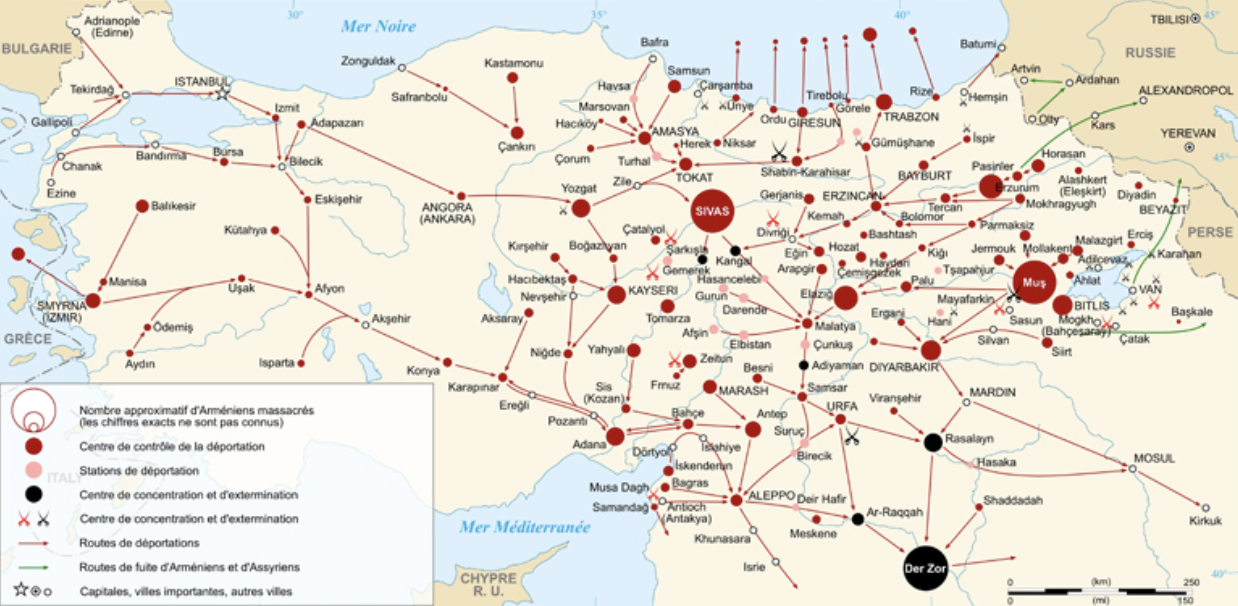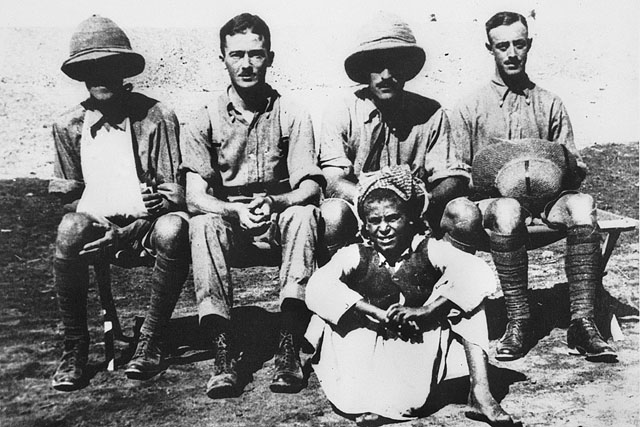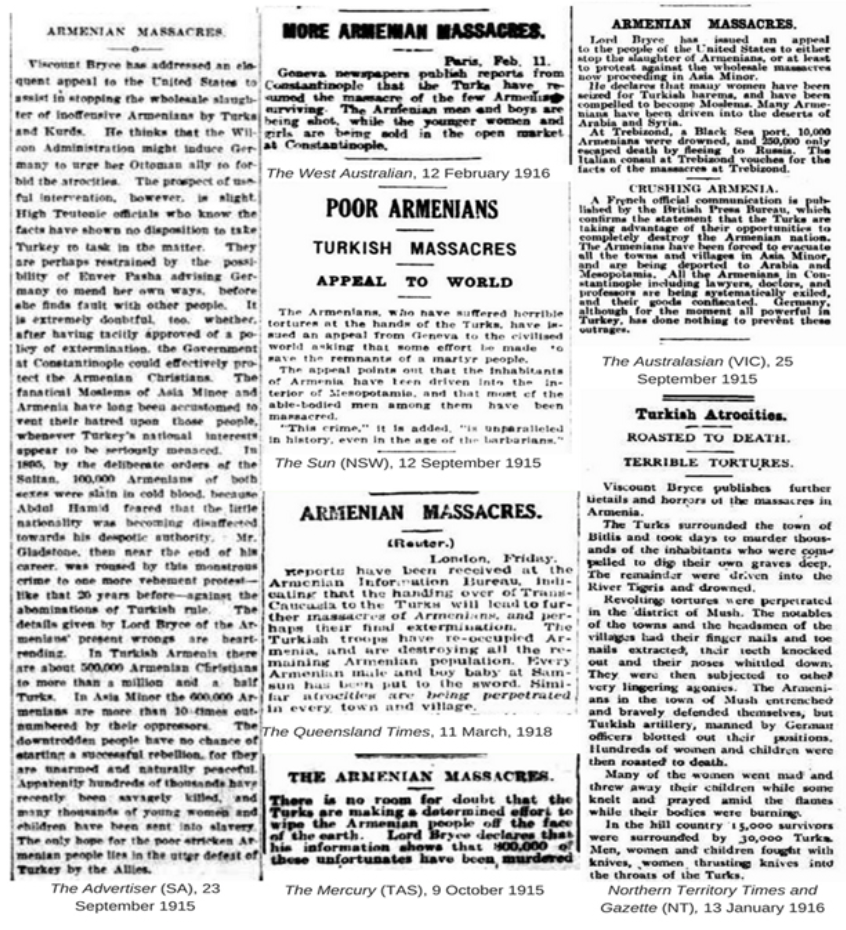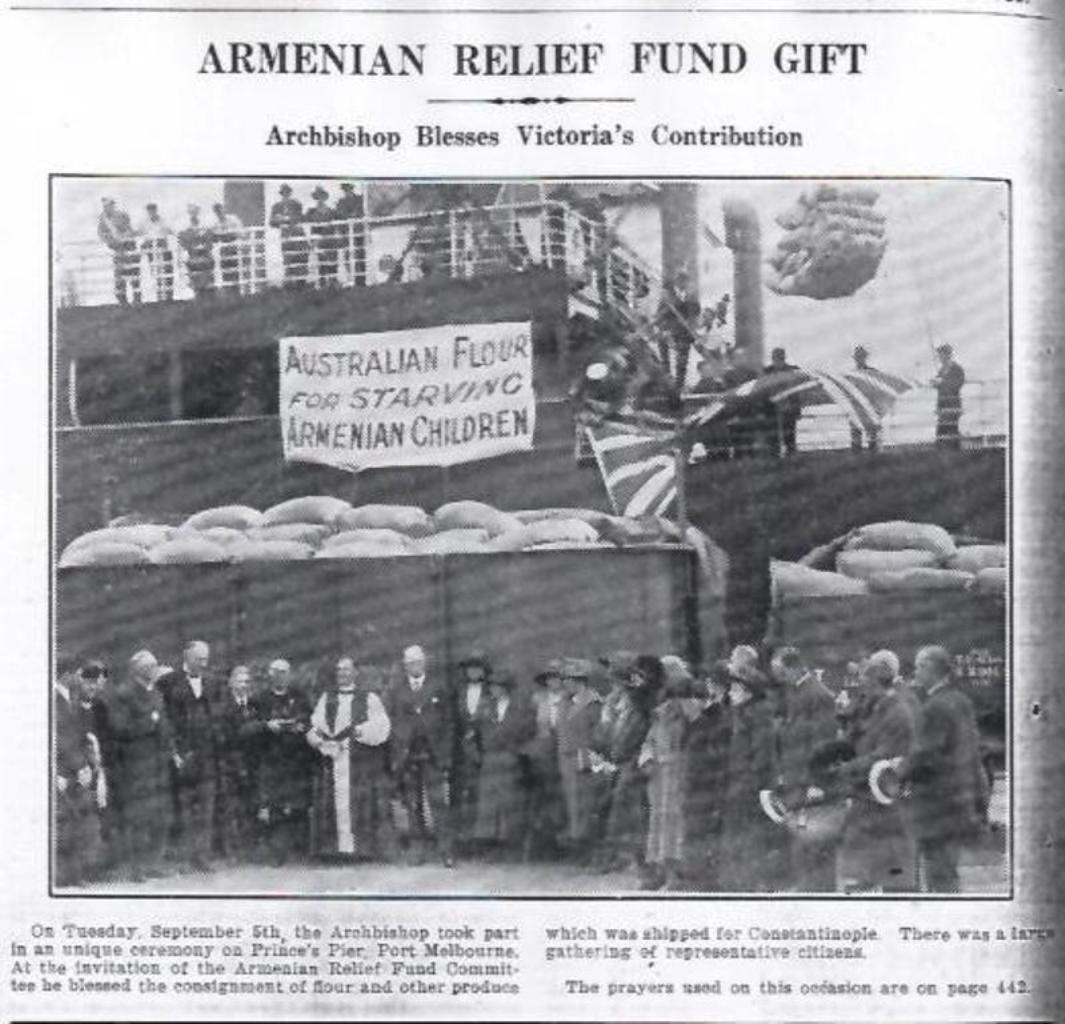Recognition of the Armenian Genocide
Why?
Recognition of the Armenian Genocide forms a fundamental aspect of the Armenian National Committee of Australia's (ANC-AU) activities, as it represents the collective wishes of a 50,000-strong Australian-Armenian community, most of whom are descendants of survivors of said genocide.How?
The ANC-AU fosters this goal through a number of events and advocacy aimed at informing the Australian public and government. This includes:- Academic Presentations by global scholars such as Professor Hans-Lukas Kieser, Professor Taner Akcam, etc.;
- Meetings with State and Federal members of Parliament;
- Commemoration events such as Recognition marches; and
- Memorials dedicated to the memory of those who died in the Armenian Genocide through the establishment of Khatchars in locations such as NSW Parliament House Sydney, St. Marys Cathedral Sydney, Beauchamp Park Chatswood, Meadowbank Bank Memorial Park, Macquarie Park Cemetery, Armenia Apostolic Church in Chatswood and the Galstaun College Ingleside campus.
Achievements
Presently. the Australian Government does not recognise the Armenian Genocide, however there have been multiple strides through the lead of ANC-AU towards having Australia recognise the Armenian Genocide. These include:- 1997: New South Wales Parliament becomes the first state government to recognise the Armenian Genocide with bipartisan support from both Premier Bob Carr and Opposition leader Peter Collins;
- 2005: The Council of Ryde unanimously recognises the Armenian Genocide and dedicates a memorial in remembrance of the 1.5 million Armenians who perished;
- 2009: The South Australian Parliament follows in the footsteps of NSW and passes a motion recognising the Armenian Genocide;
- 2015: The Council of Willoughby recognised the Armenian Genocide after witnessing the historic rise of Armenian-Australian, Gladys Berejiklian;
- 2018: Motion recognising the Armenian Genocide through the prism of the Australia's first major international humanitarian relief effort aiding orphans of the Armenian Genocide debated without dissent in the Federal House of Representatives;
- 2018: Motion honouring the 70th Anniversary of the United Nations Convention on the Prevention and Punishment of Genocide debated without dissent in the Federal House of Representatives, highlighting the historical undeniability of the Armenian Genocide and calling for Australia to recognise the Armenian Genocide;
- 2021: Federal Parliament’s House of Representatives unanimously debated in favour of a motion calling on the Australian Government to recognise the Armenian, Assyrian, and Greek Genocides, in honour of the International Day of Commemoration and Dignity of the Victims of the Crime of Genocide and of the Prevention of this Crime.
Over 70 speeches have been made across both chambers of the Federal Parliament, recognising the historical reality of the Armenian Genocide and calling for Australia's recognition of the Armenian, Assyrian and Greek Genocide.
Historical Overview
The Genocide of the Armenians by the Turkish government during World War I represents one of the greatest tragedies of modern history. In this - the first Genocide of the 20th century - almost an entire nation was destroyed.The Armenian people were effectively eliminated from the homeland they had occupied for nearly three thousand years- This annihilation was premeditated and systematically planned to be carried out under the cover of war. Persecution of Armenians by the Turkish government was unbiased as men, women, children from all classes of society were subject to horrific crimes against humanity.
1.5 Million Armenians went on to die of starvation, epidemics, and exposure to the harshest of elements during their death marches. Since there were some survivors scattered throughout the Middle East and Transcaucasia, the Turkish government saw that the very memory of the Armenian people and nation were to be obliterated.
The former existence of Armenians in Turkey was denied. Maps and history were rewritten. Churches, schools. and cultural monuments were desecrated and misnamed. Small children, snatched from their parents, were renamed and farmed out to be raised as Turks. The Turks "annexed" ancestors of the area in ancient times to claim falsely. by such deception, that they inhabited this region from ancient days.
In effect. the Turkish Government had succeeded in its diabolical plan to exterminate the Armenian population from what is now Turkey. The impunity that the Turkish State has enjoyed to this day with respect to this crime against humanity. including the economic and territorial fruits of the genocide, stems from the failure of the international community to honour their promises to punish the perpetrators.
Many historians have attributed such ignorance as the encouragement that Adolf Hitler needed to, some 20 years later, carry out a similar policy of extermination against the Jews and certain other non-Aryan or "undesirable" populations of Europe. encapsulated in his chilling rationalising statement on 22 August 1939 - "Who, after all, speaks today of the annihilation of the Armenians".

Australia and the Armenian Genocide
The news of the pain and suffering of the Armenian people reached Australia through the letters and eyewitness account of Anzacs and numerous media reports which caused dismay and anger throughout the country.The ANC-AU promotes the notion that the Armenian Genocide not only forms a major component of Armenian history but also a significant part of Australian identity as well.
Anzac Eyewitnesses to the Armenian Genocide
The Armenian Genocide is inextricably connected to the legacy of the ANZACs in the form of eyewitness accounts of Australian POWs who during their detention witnessed firsthand the brutality of the Ottoman Empire in their extermination and massacre of the Armenian people.These brave men who had witnessed the nature and horror of one of the most brutal wars in history could not believe the savagery of the Ottomans and their treatment of men, women and children. These men who fought for Australia's freedom saw that these atrocities committed by the Turkish government were the reason that they were there.
In their selflessness and honour to an unspoken duty, there have been countless accounts of ANZACs helping Armenians which the ANC-AU has collected, documented and collated over time and features a number of high-ranking officers such as Lieutenant Colonel Arthur Mills and Colonel Stanley Savige.
The ANC-AIJ is proudly dedicated to making the efforts of these Australian men and this overlooked part of ANZAC history as well as the Armenian Genocide a recognised part of Australian history.

Australian Media Covers Armenian Genocide
It was only a matter of time that the news of these war crimes would travel to Australian shores, from the written word of ANZACs and the notepads of war correspondents. As press coverage reached the Australian people, reporting race-based mass exterminations and persecutions, the pain and suffering of the Armenians and other Christian minorities of the Ottoman Empire caused great dismay throughout the country.Armenians and other Christian minorities of the Ottoman Empire caused great dismay throughout the country. While the term genocide had not yet been coined, newspapers across the country reported on the atrocities committed against the Armenians for no reason other than their ethnicity.
Due to the combined efforts of the ANC-AU, it was discovered that, between 1918 and 1923, over 10,000 articles were printed on the massacres of Armenians perpetrated by Ottoman Turkey during the First World War.
The Australian newspapers that covered the atrocities of the Ottoman Empire are still present today, including the Daily Telegraph, the Age and the Sydney Morning Herald.

Australia's Humanitarian Response to the Armenian Genocide
The ANC-AU is proud that Australia's first international humanitarian effort as a Federation was its fund for the survivors of the Armenian Genocide.For Australia. the ANC-AU has documented that there were several Australian humanitarian reliefs and efforts to assist the persecuted and entrapped Armenian men, women and children. The first amongst many was the Armenian Relief Fund which emerged in Victoria in late 1915 called the Armenian Relief Fund. The passion of Australian who bore witness to the Armenian Genocide aftermath only grew:
- December 1915: The Armenian Relief Fund was established with the purpose of providing aid to the survivors of the Armenian Genocide.
- March 1917: Lord Mayor of Melbourne. Sir David Hennessy. together with other prominent Victorians. agreed to set apart a Sunday in April for special collections on behalf of the Armenians which amounted to over €2,000. This mayoral initiative. supported by Victoria's church leaders. became the first major grassroots drive in Australia for the stricken Armenians.
- 1918: Armenian Relief committees are formally formed in Sydney and Adelaide.
- 1922: Relief committees were operating in every state in Australia and a national executive committee was formed headquartered in Adelaide, South Australia with Rev. James Edwin Crewell, a Congregationalist minister from Adelaide unanimously appointed as national secretary of the Australasian Armenian Relief Fund.


In just under 10 years, the Australian people had achieved so much including the establishment of the Australiasian Orphanage in Antelias, Lebanon.
- It housed about 1,700 Armenian orphans who had survived the Armenian Genocide.
- The director of the orphanage was Captain John Knudsen, an Anzac veteran of WWI.
- Major appeals for aid were launched throughout Australia.
- Within a short time, over $100,000 (about $1.5 million in today's terms) worth of relief supplies were collected and shipped to the refugee centres in the Near East.


Australian Reverend James E. Cresswell, Hilda J. King and Miss Gordon with Armenian Genocide orphans at
Australiasian orphanage, Antelias, Lebanon, 1923
Even the Australian government took part in this heroic effort to help the survivors of the genocide where then Prime Minister of Australia, Billy Hughes, promised that free freight would be provided by the Commonwealth Steamers (Australian government shipping vessels) for the goods collected by the relief committees.Many Australians were at the forefront in providing relief to the survivors of the Armenian, Greek and Assyrian Genocides. This should be made known by all Australians, so they are proud of their history which involved assisting the survivors of the Armenian Genocide.